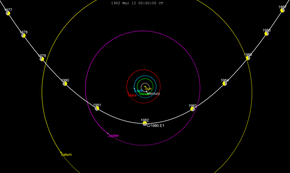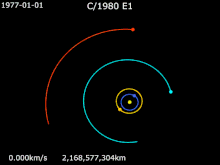 Hyperbolic path with annual motion | |
| Discovery | |
|---|---|
| Discovered by | Edward L. G. Bowell |
| Discovery date | 11 February 1980 |
| Designations | |
| C/1980 E1 | |
| Orbital characteristics[2] | |
| Epoch | JD 2444972.5 (3 January 1982) |
| Observation arc | 6.88 years |
| Number of observations | 187 |
| Aphelion | ~75000 AU (inbound)[1] |
| Perihelion | 3.3639 AU[2] |
| Eccentricity | 1.057[2] (hyperbolic trajectory) 1.053 (epoch 1984+)[1] |
| Orbital period | ~7.1 million years (epoch 1950)[1] Ejection (epoch 1977+)[1] |
| Inclination | 1.6617° |
| 114.558° | |
| Argument of periapsis | 135.083° |
| Last perihelion | 12 March 1982[2] |
| Physical characteristics | |
| Dimensions | > 1 km |
C/1980 E1 is a non-periodic comet discovered by Edward L. G. Bowell on 11 February 1980 and which came closest to the Sun (perihelion) in March 1982. It is leaving the Solar System on a hyperbolic trajectory due to a close approach to Jupiter. In the 43 years since its discovery only two objects with higher eccentricities have been identified, 1I/ʻOumuamua (1.2) and 2I/Borisov (3.35).[3][4]
Overview
[edit]Before entering the inner Solar System for a 1982 perihelion passage, C/1980 E1 had a barycentric (epoch 1950-Jan-01) orbit with an aphelion of 75,000 AU (1.2 ly), and a period of approximately 7.1 million years.[1]
As the comet was approaching on 9 December 1980, it passed within 0.228 AU of Jupiter,[2] which accelerated the comet briefly giving an (epoch 1981-Jan-09) eccentricity of 1.066.[1] The comet came to perihelion on 12 March 1982,[2] when it had a velocity of 23.3 km/s (52,000 mph) with respect to the Sun. Since the epoch of 1977-Mar-04, C/1980 E1 has had a barycentric eccentricity greater than 1,[1] keeping it on a hyperbolic trajectory that will eject it from the Solar System. Objects in hyperbolic orbits have a negative semimajor axis, giving them a positive orbital energy. After leaving the Solar System, C/1980 E1 will have an interstellar velocity () of 3.77 km/s.[a] The Minor Planet Center does not directly list a semimajor axis for this comet.[5]
The escape velocity from the Sun at Neptune's orbit is 7.7 km/s. By June 1995, the comet was passing Neptune's orbit at 30.1 AU from the Sun continuing its ejection trajectory at 8.6 km/s.[6] Since February 2008, the comet has been more than 50 AU from the Sun.[7]
| Date | Sun distance (AU) |
Velocity wrt Sun (km/s) |
Uncertainty region (3-sigma) |
|---|---|---|---|
| 1682-03-12 | 248.8 AU (37.22 billion km; 23.13 billion mi) | 2.68 | ± 7 million km |
| Perihelion | 3.364 AU (503.2 million km; 312.7 million mi) | 23.3 | ± 1589 km |
| 2282-03-12 | 337.2 AU (50.44 billion km; 31.34 billion mi) | 4.43 | ± 5 million km |
Emission of OH (hydroxide) was observed pre-perihelion while the comet was nearly 5 AU from the Sun.[9] CN (cyanide) was not detected until the comet was near perihelion. The comet nucleus was estimated to have a radius of several kilometers. The surface crust was probably a few meters thick.


C/1980 E1 (Bowell) · Sun · · Earth · Mars · Jupiter · Saturn
See also
[edit]- List of Solar System objects by greatest aphelion
- List of hyperbolic comets
- List of non-periodic comets
- List of periodic comets
- 1I/ʻOumuamua
- 2I/Borisov
Notes
[edit]- ^ v = 42.1219 √1/r − 0.5/a, where r is the distance from the Sun, and a is the major semi-axis. At epoch 2500, C/1980 E1 will have a barycentric semi-major axis of −62.44.
References
[edit]- ^ a b c d e f g Horizons output. "Barycentric Osculating Orbital Elements for Comet C/1980 E1 (Bowell)". Solution using the Solar System Barycenter. Ephemeris Type:Elements and Center:@0 (To be outside planetary region, inbound epoch 1950 and outbound epoch 2050)
- ^ a b c d e f "JPL Small-Body Database Browser: C/1980 E1 (Bowell)" (last observation: 1986-12-30). Retrieved 26 September 2015.
- ^ de la Fuente Marcos, Carlos; de la Fuente Marcos, Raúl (1 November 2017). "Pole, Pericenter, and Nodes of the Interstellar Minor Body A/2017 U1". Research Notes of the AAS. 1 (1): 9 (2 pages). arXiv:1711.00445. Bibcode:2017RNAAS...1....5D. doi:10.3847/2515-5172/aa96b4. S2CID 119537175.
- ^ de León, Julia; Licandro, Javier; Serra-Ricart, Miquel; Cabrera-Lavers, Antonio; Font Serra, Joan; Scarpa, Riccardo; de la Fuente Marcos, Carlos; de la Fuente Marcos, Raúl (19 September 2019). "Interstellar Visitors: A Physical Characterization of Comet C/2019 Q4 (Borisov) with OSIRIS at the 10.4 m GTC". Research Notes of the AAS. 3 (9): 131. Bibcode:2019RNAAS...3..131D. doi:10.3847/2515-5172/ab449c. ISSN 2515-5172. S2CID 204193392.
- ^ "C/1980 E1 (Bowell) Orbit at the Minor Planet Center". Retrieved 28 September 2015.
- ^ "Horizons Batch: Passing Neptune's orbit at 30.1 AU from the Sun" (Solar escape velocity at 30.1 AU is about 7.67 km/s). JPL Horizons.
- ^ Yeomans, Donald K.; Chamberlin, Alan B. "Horizons Ephemeris". JPL Solar System Dynamics. Retrieved 22 February 2011.
- ^ "Horizons Batch for Distance and Velocity using a 300 year stepsize". JPL Horizons. Retrieved 3 February 2023.
- ^ Ahearn, Michael F.; Schleicher, D. G.; Millis, R. L.; Feldman, P. D.; Thompson, D. T. (1984). "Comet Bowell 1980b". Astronomical Journal. 89: 579–591. Bibcode:1984AJ.....89..579A. doi:10.1086/113552.
External links
[edit]- C/1980 E1 at the JPL Small-Body Database



Well, that’s interesting to know that Psilotum nudum are known as whisk ferns. Psilotum nudum is the commoner species of the two. While the P. flaccidum is a rare species and is found in the tropical islands. Both the species are usually epiphytic in habit and grow upon tree ferns. These species may also be terrestrial and grow in humus or in the crevices of the rocks.
View the detailed Guide of Psilotum nudum: Detailed Study Of Psilotum Nudum (Whisk Fern), Classification, Anatomy, Reproduction